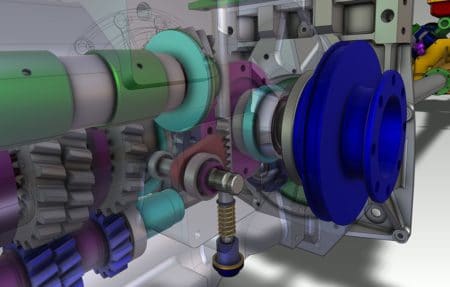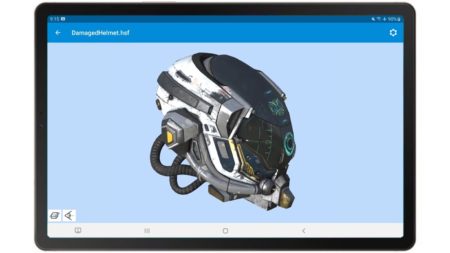Continued from page 1
Apple Silicon
HOOPS 2022 technology SDKs now support developers who need Apple Silicon. In other words, those developers who are shipping products that run on Apple Mac computer systems. The resurgence in Apple computers in enterprise markets has been a slow but constant growth curve going back nearly two decades now since Steve Jobs’s tenure as Apple CEO.
The Mac is still one of the premier desktop platforms that we support.
Apple’s chip design leadership in the mobile space, along with ARM architecture advancement in general, has led Apple to the place where it can leave Intel and X86 chip architecture on Macs and provide best-in-class performance per watt leadership in the desktop and laptop computer market.
Apple Silicon support is a big part of HOOPS 2022 SDK technologies. Apple’s own in-house ARM-architecture chip designs are providing world-leading performance per watt metrics.
Known as “Apple Silicon,” Apple’s first M1 chip temporarily held absolute performance leadership in single-core processing over Intel. Now the enterprise CAD industry must contend with not two main chip rivals in AMD and Intel, but Apple and more to come, including Qualcomm and MediaTek, all on custom ARM architectures.
Those developers looking to make sure their solutions can run everywhere are turning to Tech Soft 3D. “The Mac is still one of the premier desktop platforms we support,” says Fritz. “It’s necessary for us to keep up with what is happening in the industry on all the operating systems and hardware platforms and end devices.”
Ron Fritz noted that his company has long supported iOS, which runs on ARM chips powering the iPad. “We supply technologies to companies like Shapr3D,” he adds. “They are a great example of a really nice application for mobile. Interestingly, there have not been many truly mobile applications like Shapr3D. I think many companies have decided their mobile strategy is their cloud strategy. Mobile devices have browsers.”
OpenGL and the Graphics APIs
Tech Soft 3D’s Apple Silicon support brings up questions about Apple Metal, Vulkan, and DirectX technologies. Jonathan Girroir noted that underlying graphics technology is non-trivial and can represent a huge investment on their end.
“We know and are aware of Apple’s divergence from OpenGL and deprecation of it,” says Girrior, “so in our 2022 HOOPS release, we have released graphics on Metal support in beta for now. So we do have a pipeline for Metal. In our next release in March, we will be out of beta and into official support for Apple Metal,” he adds.
There was the urgency with Metal because of Apple’s push, and we will get there with Vulkan, but interestingly, engineering software companies are not fast about these things.
Metal’s support brings up Vulkan, a competing low-level (less abstraction) cross-platform graphics API from the Khronos Group. “Because Metal shares a lot of architecture in terms of how we had to redo our pipelines, Vulkan will probably be the next target for us,” says Girrior.
Both Fritz and Girroir reiterated that Metal is something they had to do because of Apple’s planned elimination of OpenGL support. This puts DirectX 12 and Vulkan in a different light. “There was the urgency with Metal because of Apple’s push, and we will get there with Vulkan,” says Fritz, “but interestingly, engineering software companies are not fast about these things. Game companies are much more sensitive to being right there with the latest hardware advantages.”
Fritz noted that one of the advantages of adopting these newer graphics APIs like Metal and Vulkan is the quality and visual fidelity. There are also new standards for visually representing data like physically-based rendering (PBR) and glTF format support, included in HOOPS 2022.
MCAD Growth
HOOPS 2022 includes many new features aimed at the manufacturing CAD industries. “We have added new measurement tools functionality in our SDKs,” adds Girrior. “This may be important for doing measurements that are not baked into the geometry data.”
“What is interesting is we bridge this world between MCAD and AEC, and the way that data is represented and interacted with is really different,” he notes, adding that in the MCAD world, data isn’t as loose as it is in the AEC world. “In MCAD, you have this idea of boundary representation, Brep data—it’s very accurate,” he says.

Data will play a larger role in the MCAD space as new types of workflows demand more metadata about components and geometry in models. HOOPS 2022 also has a new Animation Manager with a set of classes for scripting animations.
Data in AEC can be faceted, triangles, faces of a wall. “To be able to take that and do measurements is a different workflow,” he says, “so we have come out with a set of tools that allow developers and their end-users the ability to add measurement capability to AEC data quickly.”
HOOPS 2022 also features a new Animation Manager, essentially a new set of classes that allow the scripting of animations. “The set of classes allow scripting of keyframes on a timeline that interpolates between camera location, changes of color, transparency, and objection location,” adds Girrior.
So our business is just 100 percent focused on making it intuitive and frictionless for developers to create impactful engineering applications.
But Fritz says the significant new values to MCAD in HOOPS technology center around all the data that sits on top of the geometry. “There has been a real drive in manufacturing intelligence.”
Advertisement
“We have done a great job reading and visualizing geometry from a large variety of systems,” says Fritz, “now it’s about bringing the plethora of metadata and related information together, mining its relevance, and serving it in intelligent ways. We are at the stage where accurate geometry is table stakes.”
Today’s most advanced MCAD applications need to add intelligence levels that add value at multiple points in the process. “The more metadata, the more information, the smarter stuff your application can do,” adds Fritz.
Understanding what is in the CAD file helps applications to make decisions. This adds key values to manufacturing as a service (MaaS).
Future
“So our business is just 100 percent focused on making it intuitive and frictionless for developers to create impactful engineering applications,” says Fritz.
“And what that means for us is that when we sit down with a software developer and they say ‘here is what we are trying to build and here is what we need,’ we want to be able to say, ‘we can help you with that’ no matter what they say.”

HOOPS Exchange 2022 now supports the export of glTF and GLB file formats, which support 3D models with PRB materials.
This push to be a complete source for CAD development support led Tech Soft 3D to acquire analysis and simulation companies Ceetron AS and Visual Kinematics. “There were pieces of the puzzle we were missing,” adds Fritz. “Very often applications do analysis and simulation and require meshing analysis, solvers, and post-processing visualization—tools used in the CAE market.”
In addition to these evolving directions for Tech Soft 3D, Fritz noted that VR and AR developers are flocking to Tech Soft 3D because they now need to support CAD formats natively in their VR and AR applications. “This has been a real boom for us, and they want to use our tools to do that. There’s even a buzzword for that called the metaverse.”
With some of the biggest industrial CAD giants as their customers and partners, new capacities to serve the CAE markets, and VR and AR developers rushing to get real CAD file formats merged into their game-engine and game-like software environments, Tech Soft 3D is set for growth across several vectors.




Reader Comments
Comments for this story are closed